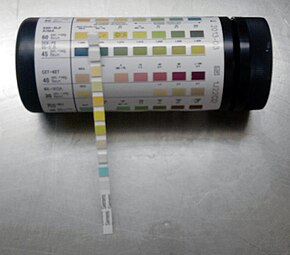Our website is made possible by displaying online advertisements to our visitors.
Please consider supporting us by disabling your ad blocker.
Urine test strip
| Urine test strip | |
|---|---|
 The Multistix urine test strip showing the manufacturer's coloured scale. | |
| Purpose | determine pathological changes |
A urine test strip or dipstick is a basic diagnostic tool used to determine pathological changes in a patient's urine in standard urinalysis.[1]
| Leukocytes | |
| Nitrite | |
| Urobilinogen | |
| Protein | |
| pH | |
| Haemoglobin | |
| Specific gravity | |
| Ketone | |
| Bilirubin | |
| Glucose | |
A standard urine test strip may comprise up to 10 different chemical pads or reagents which react (change color) when immersed in, and then removed from, a urine sample. The test can often be read in as little as 60 to 120 seconds after dipping, although certain tests require longer. Routine testing of the urine with multiparameter strips is the first step in the diagnosis of a wide range of diseases. The analysis includes testing for the presence of proteins, glucose, ketones, haemoglobin, bilirubin, urobilinogen, acetone, nitrite and leucocytes as well as testing of pH and specific gravity or to test for infection by different pathogens.[2]
The test strips consist of a ribbon made of plastic or paper of about 5 millimetre wide. Plastic strips have pads impregnated with chemicals that react with the compounds present in urine producing a characteristic colour. For the paper strips the reactants are absorbed directly onto the paper. Paper strips are often specific to a single reaction (e.g. pH measurement), while the strips with pads allow several determinations simultaneously.[2]
There are strips which serve different purposes, such as qualitative strips that only determine if the sample is positive or negative, or there are semi-quantitative ones that in addition to providing a positive or negative reaction also provide an estimation of a quantitative result, in the latter the colour reactions are approximately proportional to the concentration of the substance being tested for in the sample.[2] The reading of the results is carried out by comparing the pad colours with a colour scale provided by the manufacturer, no additional equipment is needed.[3]
This type of analysis is very common in the control and monitoring of diabetic patients.[2] The time taken for the appearance of the test results on the strip can vary from a few minutes after the test to 30 minutes after immersion of the strip in the urine (depending on the brand of product being used).
Semi-quantitative values are usually reported as: trace, 1+, 2+, 3+ and 4+; although tests can also be estimated as milligrams per decilitre. Automated readers of test strips also provide results using units from the International System of Units.[2]
- ^ Yetisen A. K. (2013). "Paper-based microfluidic point-of-care diagnostic devices". Lab on a Chip. 13 (12): 2210–2251. doi:10.1039/C3LC50169H. PMID 23652632.
- ^ a b c d e Strasinger SK, Di Lorenzo Schaub M (2008). "5". Análisis de orina y de los líquidos corporales (in Spanish) (5ª ed.). Editorial panamericana. pp. 53–76. ISBN 978-950-06-1938-7. Retrieved March 13, 2012.
- ^ http://www.seg-social.es/ism/gsanitaria_es/ilustr_capitulo6/cap6_7_analisorina.htm Archived 2011-03-16 at the Wayback Machine language = Spanish
Previous Page Next Page


